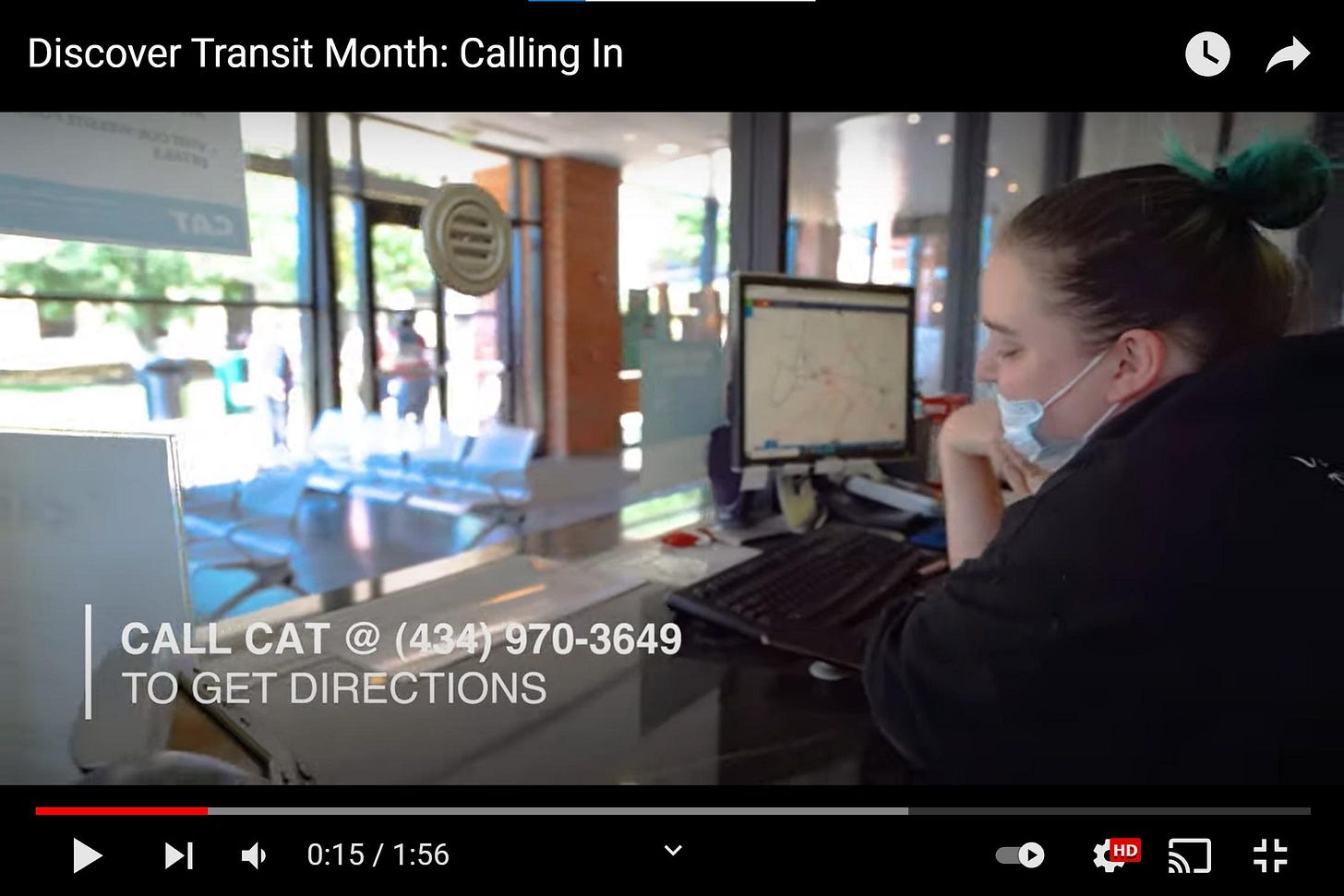In today's subscriber-fueled public service announcement: Lovers of used books rejoice! The Friends of the Jefferson Madison Regional Library will resume the tradition of their annual Fall Book Sale this October 2nd through October 10 at a new location! The Friends of the Library sale will take place at Albemarle Square Shopping Center from 10 a.m. to 7 p.m. each day. Half-price days on October 9 and October 10. Questions? Visit jmrlfriends.org for more information.
On today’s show:
Locals weigh in on how redistricting would treat Albemarle when new legislative districts are approved
Albemarle County’s Board of Supervisors get an update on the Comprehensive Plan
Investment firm takes majority stake in Apex Clean Energy
Jaunt hires Tulsa’s top transit official
A company called the Ares Management Corporation has acquired a majority stake in the Charlottesville-based Apex Clean Energy, according to a release on Business Wire.
“The transaction will provide Apex with additional equity growth capital as it seeks to transition to a pure-play renewable energy independent power producer (IPP),” reads the release.
Apex has over $9 billion in utility-scale energy projects across the country. Ares has already been an investor on projects such as the construction of the largest single-phase, single-site wind facility in the country.
“Through origination, construction, and operation of utility-scale wind, solar, and storage facilities, distributed energy resources, and green fuel technologies, Apex is expanding the renewable frontier across North America,” reads the description of Apex Clean Energy in the release.
The same management team will remain in place. The company has over 300 employees. Construction continues on their new headquarters in downtown Charlottesville.
Jaunt has hired the head of the Metropolitan Tulsa Transit Authority to be its next chief executive officer. Ted Rieck will start work on December 6 and interim CEO Karen Davis will continue on as chief operating officer. In Tulsa, Rieck oversees a public transit fleet that serves five communities and has a $23 million budget.
According to the agenda for the most recent meeting of the authority’s seven-member board, Rieck has faced many of the same challenges facing transit agencies in our area such as a shortage of people willing to be drivers as well as COVID testing employees. According to the minutes of the August meeting, Rieck had announced his retirement from Tulsa to the board. (September meeting packet)
This is of course Try Transit Month and this morning there was a stakeholder meeting for the Regional Transit Vision plan under way. I’ll have more on that in a future installment of the program. But all of the local transportation providers have banded together to produce a series of videos about how you can discover transit. The first one is called Calling In. Take a look and if you share it, use the hashtag #busorbust on Twitter when you share it with all of your friends. (watch)

Remembering Middleditch
When the Albemarle Supervisors met on Wednesday, Supervisor Ann Mallek noted the passing of Leigh Middleditch, a lawyer with a long history in Charlottesville affairs, at the age of 92.
“People of his and my parents’ generation worked in so many different ways to build community here,” Mallek said. “He was always focused on collaboration and finding solutions with people of all comers, all ages, all neighborhoods, all locations.”
Mallek said that Middleditch organized an effort to improve transportation funding in the area in the mid-2000’s.
“He also founded the Planning and Coordination Council to bring city, county, and UVA together to find solutions to local problems from the water supply plan to roadway to all sorts of things that are local group is dealing with today,” Mallek said.
The Planning and Coordination Council was disbanded in 2019 in favor of a closed-door body known as the Land Use and Environmental Planning Committee. There was an update on their efforts on the Board of Supervisors’ consent agenda. (LUEPC update)
Supervisor Liz Palmer noted Middleditch was actively engaged in efforts to make this year’s redistricting less partisan than in years past under the OneVirginia2021 initiative.
“He also was instrumental in the Virginia 2021 redistricting revisions and getting that going,” Palmer said.
In a bit, we’ll hear more about redistricting. Read more on Middleditch’s legacy in any one of these articles:
From the newsroom: We say goodbye to civic leader and Charlottesville Tomorrow board member Leigh Middleditch, Jr., Charlottesville Tomorrow
Middleditch, activist who fomented change in state and region, died at 92
Comprehensive Plan update
In yesterday’s newsletter, we heard about the beginnings of fire engine service from a fire station on Pantops at station 16. I had hoped to get a quote in from someone at the Board of Supervisors meeting when this was announced, and here it is from Supervisor Chair Ned Gallaway.
“Having a full fire engine along with an ambulance stationed at Pantops, which is our second busiest area in the county not only helps the immediate area of Pantops, but this impacts our entire system,” Gallaway said. “So now that other places that are just as busy as areas don’t have to get pulled out and over to [Pantops], they can serve as the secondary or the backup to Station 16.”
For decades, Albemarle County has planned for growth and investments such as the Pantops public safety station by concentrating residential development into designated areas. That’s codified in the county’s Comprehensive Plan which was last adopted in July 2015. Michaela Accardi is a senior planner with Albemarle County.
“The Comprehensive Plan or the comp plan establishes Albemarle’s long-range vision that guides growth, development, and change for the next 20 years,” Accardi said. “The Comprehensive Plan serves as the basis for land use development regulations and decisions, such as rezoning and special use permits, capital improvements, new county programs and the distribution of county budget dollars to programs and agencies.”
Earlier this year, the Board of Supervisors directed the next plan review to take place at the same time changes are made to the county’s zoning ordinance. Accardi said the Comprehensive Plan needs to be updated to reflect new initiatives and policies adopted by the county, many of which are summarized in a strategic plan adopted by the Board in 2018. (download the presentation)
“The Board’s strategic plan includes climate action planning, economic development, infrastructure planning, revitalizing aging neighborhoods, and expanding broadband,” Accardi said.
Economic development is codified in the Project ENABLE plan. The Climate Action Plan was adopted last October. Housing Albemarle was adopted this past July. Now, the Comprehensive Plan has to be updated to reflect this general direction for the county.
“Finally, to further the county’s commitment to providing the highest level of public service and enhancing the quality of life for all its residents, the county’s Office of Equity and Inclusion was created in 2018,” Accardi said.
Accardi said staff hopes to take from best practices in planning to integrate all of these into a new plan. One cited is Minneapolis 2040.
“Which reviewed the city’s land uses to identify opportunities for a mixture of housing types and levels of affordability,” Accardi said.
Others include Richmond 300: A Guide for Growth and Memphis 3.0. The latter has the tag line “In our third century, Memphis will build up, not out.”
Phased approached to zoning review
Rachel Falkenstein, a planning manager with Albemarle, said the zoning review will take place over many phases with adoption of several steps at a time.
“Phase 1 will be focused on simplification and clarity of a few topics such as use classification and setbacks and work on this phase has already begun,” Falkenstein said. “Phase 2 of the zoning update will be intended to focus on resource preservation topics such as dark skies, tree preservation, and historic preservation.”
Phase 3 would look at street standards in commercial and industrial zoning districts and Phase 4 will update residential and mixed-use zoning districts.
Most of the presentation dealt with the scope of the Comprehensive Plan update. The first phase will take a look at the central cornerstone of the plan for decades.
“Phase 1 is called Growth Management Policy and Plan Framework and the goal of this phase is to review, evaluate, and if needed update the growth management policy through the lens of equity, climate action, and county capacity projections,” Falkenstein said.
Work is underway on this phase. The second phase will look at what other topics should be highlighted in the plan and a review of the existing plan. Phase 3 will see the creation of action steps for implementation.
“In Phase 3 we also intend to detail out each of our topics and determine how the topic goals should be implemented and we’ll identify metrics for each of our topics so that we can track progress moving forward,” Falkenstein said.
Phase 4 will bring the draft document together. Falkenstein said the goal is to have an updated document ready for adoption in the middle of 2024.
More details will return to the Board at their first meeting in November when the Board will have a work session on how community engagement for the plan review will take place.
Supervisor Diantha McKeel supported the approach.
“I do like the targeted look at specifics rather than try to do a broad Comprehensive Plan all at one time,” McKeel said. “I think this is absolutely the way to go.”
Supervisor Liz Palmer sought more specifics for what specific changes needed to be reviewed in the zoning ordinance as part of this process. Falkenstein had this answer.
“Our zoning map does not match our comp plan land use map in a lot of places and that’s an additional step we could take to prioritize,” Falkenstein said.
In another public service announcement, want to take a tour of Secret Charlottesville? On October 15, the Albemarle Charlottesville Historical Society will lead a tour based on author Marijean Oldham’s new book Secret Charlottesville: A Guide to the Weird, Wonderful, and Obscure. The tour begins at 7 p.m. and is free, though donations are welcome. The book is available at New Dominion Bookshop. Email the ACHS to reserve your spot.
Locals weigh in on redistricting
The Virginia Redistricting Commission next meets tomorrow after a week of public hearings in which participants were asked to weigh in on two different maps for both the 40 seats in the Virginia Senate as well as the 100 seat House of Delegates.
The 16-member commission was able to reach consensus between different versions produced by Democratic and Republican consultants. Yesterday, it was the Charlottesville area’s turn to weigh in on the different maps. Here’s Commissioner Sam Kumar of Alexandria, who chaired yesterday’s public hearing.
“The most recent House of Delegates maps are A7 and B6,” Kumar said. “The most recent Senate maps are A5 and B4.”
You can take a look at the maps here to follow along.
Under the A7 Statewide map for the House of Delega tes drawn by the Republican consultant, Albemarle County is split into three legislative districts. Northern Albemarle would be in the 74th District along with all of Greene and some of Orange County. Charlottesville would be in the 75th District along with much of Ivy in Albemarle County. Southern Albemarle would be in the 76th District along with all of Amherst and Nelson counties. (A7 map comment page)
Under the B6 Statewide Map for the House of Delegates drawn by the Democratic consultant, Albemarle is in two districts. Charlottesville would be in the 80th district with central-eastern Albemarle. All of Albemarle County would be in the 81st District along with a portion of eastern Augusta County. (B6 map comment page)
Former Charlottesville Mayor Kay Slaughter went first during the public comment period to object to how Albemarle County was treated under both plans.
“The Republican plan divides it into three districts,” Slaughter said. “The Democratic plan makes it one district which crosses the Blue Ridge to August County, and while Augusta County and Albemarle County may share these beautiful mountains they are not a community of interest. Neither does Albemarle share interest with the Lynchburg area an hour to the south.”
Slaughter urged the Commission to redraw the maps to include parts of Nelson, Fluvanna, or Greene because they are all are part of the Thomas Jefferson Planning District Commission.
Currently, Albemarle’s House delegation is split into four legislative districts. Albemarle County resident Michael Rodemeyer asked for a less fractured map.
“My plea to you is pretty simple,” Rodemeyer said. “Keep Albemarle County together. Taken together, Albemarle County and Charlottesville almost make up enough of population for two House of Delegate districts. We only need about another 12,000 to 13,000 people for there to be a complete district.”
Tim Hickey ran as a Democrat in the 59th district in 2019. He urged the Commission to support a major theme in map B6.
“Map B6 keeps Albemarle County as unified as possible by keeping us into two districts,” Hickey said. “Not three, not four, but two, and that needs to be non-negotiable.”
Hickey suggested that Albemarle be included with Nelson rather than Augusta, but that Amherst has nothing to do with either despite the presence of U.S. 29.
“I have spent a lot of time on that stretch of road,” Hickey said. “People in Amherst largely use it to go back and forth to Lynchburg and people in Nelson largely use it to go back and forth to Charlottesville. When I was campaigning, people south of Nelson County, the voters, would routinely ask me if I were in the right place. They would say ‘we’re not in the same district as people in southern Albemarle.”
Edgar Lara of the group Sin Barreras said he could see a Congressional district that included Albemarle and Augusta County. His family has lived in the Waynesboro era for over twenty years and he lives in Albemarle.
“My community is primarily one of immigrants or children of immigrants with us speaking Spanish as our first language and working the same types of jobs, we have a similar culture and experience many of the same challenges in our communities of Virginia,” Lara said.
Pete Costigan of Ruckersville also said that Augusta and Albemarle don’t share enough interests to be in the same district.
“Greene County residents have more common interest with Albemarle County than they do with either Page or Rockingham,” Costigan said. “Specifically, Greene County residents largely drive to Albemarle for shopping or medical care.”
Under the A5 statewide map for the Senate drawn by the Republican consultant, Albemarle and Charlottesville would be within the 31st District along with Nelson, Fluvanna, and Buckingham counties. (A5 Senate map)
The B4 statewide map drawn by the Democratic consultant is similar, but the 31st District would include Greene rather than Nelson. (B4 Senate map)
The Virginia Redistricting Commission meets tomorrow at beginning at 9 a.m. Visit virginiaredistricting.org to learn more. (view maps and plans)
Thanks for reading! If you’d like to support the work, please consider a subscription through Substack, a contribution through Patreon, or send it on to someone else you think might be interested. Everyone gets a personalized thank you, as every new subscriber or patron makes me work that much harder.




















Share this post